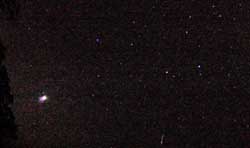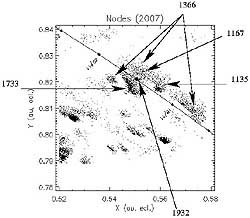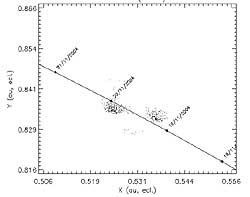|
LEONID news
2011 DRACONIDS: NEXT BIG OUTBURST
The 2011 Draconids are expected to peak over Europe at rates of about 200/h in a clear sky on October 8 (600/h high in the mountains): many slow-moving meteors for about an hour centered on 19:57 UT. A bad Moon will hamper observations from the ground, but it should still be an unusual sight. Look away from the Moon. North America will be in daylight so that the shower is not visible from there. Asia will be on the wrong side of the Earth to face the shower. [More here]
2010 LEONIDS: BACK TO NORMAL
The leonid storm season has ended, with the next outbursts not predicted until around 2028. That means, for now peak rates will be around 12 an hour in the early morning hours. To see the expected rate from your location, go here, and select the shower "Leonids" and the date of the observation (around Nov 17-18).
 Region of visibility of the 2009 Leonid outburst [click for larger version]
Region of visibility of the 2009 Leonid outburst [click for larger version]
2009 LEONID OUTBURST FORECAST
A
significant shower is expected this year when Earth crosses the 1466-dust
and 1533-dust ejecta of comet 55P/Tempel-Tuttle. According to J. Vaubaillon,
the narrow (about 1-hr) shower is expected to peak on November 17, 2009,
at 21:43 (1466) and 21:50 (1533) UT, perhaps 0.5 to 1.0 hour later based
on a mis-match in 2008, with rates peaking at
about ZHR = 115 + 80 = 195/hr (scaled to rates observed in 2008).
E. Lyytinen, M. Maslov, D. Moser, and M. Sato all
predict similar activity from both trails, combining to about ZHR = 150 - 300
/hr. P. Jenniskens notes that if the calculated trail pattern is slightly
shifted in
the same manner as observed before, then the 1533-dust trail would move in
Earth's path and its rates would be higher (the 1466-dust trail would
move away). However, the 1533-dust trail
is distorted in the models, and because of that it is not clear how
much higher that would be. This remains a rare opportunity to study
old dust trails from comet 55P/Tempel-Tuttle. In such old trails,
the model of Lyytinen
and Nissinen predicts wide trails, which can be tested by measuring
the width of the outburst profile.
[Latest updates]
Update Nov. 12: Nepalese astronomer P. Atreya is organizing an international
ground-based observing campaign near Kathmandu, Nepal, where he will be joined by P. Jenniskens,
J. Vaubaillon, and others. First reports will be posted here.
 Two Leonids were captured on 2007 November 18 at 12:56:45-56:55 UT in this all-sky image by Peter Jenniskens from Fremont Peak Observatory, California
Two Leonids were captured on 2007 November 18 at 12:56:45-56:55 UT in this all-sky image by Peter Jenniskens from Fremont Peak Observatory, California
2007 LEONIDS, FIRST IMPRESSION
A crystal clear night here in N. California resulted in these two Leonids being captured in one image. The bright light in the east is Venus. The Leonid ZHR on Nov. 18 9:30-13:30 UT was measured at 23 +/- 4. The International Meteor Organization reports that rates continued to increase and has reached ZHR ~ 42/hr over Europe in the night of Nov. 18/19. This is stronger than expected for the annual Leonid shower and shows that the Filament component has returned. Sadly, we will not be able to confirm the high rates in N. California, because of overcast skies tonight - Peter Jenniskens.
See also this Taurid meteor of Nov. 18 11:03:54 UT and comet 17P/Holmes. Many of our meteor showers such as the Taurids may have originated in a process of fragmentation similar to that experienced now by 17P/Holmes.
 Location of comet Tempel-Tuttle's dust trails at Earth orbit in November 2007 in calculations by Jeremie Vaubaillon (Caltech).
Location of comet Tempel-Tuttle's dust trails at Earth orbit in November 2007 in calculations by Jeremie Vaubaillon (Caltech).
2007 LEONID FORECAST
Earth will have an encounter with the 1932-dust trail of comet 55P/Tempel-Tuttle on 2007 November 18 at 23:03 UT, according to Jeremie Vaubaillon (Caltech). Esko Lyytinen of Finland put the peak time earlier at 22:36 UT. Meteors would radiate from R.A. = 154.0 deg., Decl. = +21.4 deg., at geocentric speed of 70.9 km/s, according to I. Sato. The trail encounter is similar to that last year and peak rates are expected to be less, somewhere around ZHR = 30 /hr. The outburst will last only 1-2 hours (FWHM about 0.68 hours, according to Jenniskens 2006). What you can see.
2006 LEONID RESULTS
In a paper submitted to Icarus, P. Jenniskens et al. report on the lack of frail meteoroids during the 2006 Leonid shower. For the similar 2007 encounter, they anticipate a peak rate of about ZHR = 32 Leonids/hr and a magnitude distribution index close to 2.6. Full paper [text], [Table], [Figures]
2006 LEONID FORECAST
The 2006 Leonids will show a dust trail encounter with the 1932-dust trail of comet 55P/Tempel-Tuttle, as well as the possible return of the Filament component. David Asher's original prediction put the peak time at 04:45 UT on November 19, with a peak rate of about 100 per hour, visible from western Europe and western Africa. Peak time of the Filament component is uncertain. The traditional maximum of the annual Leonid shower is earlier on November 17, around 16:45 UT, well placed for the western USA (early morning of November 18 local time). More information:
2005 LEONID FORECASTING
The 2005 Leonids are expected to show only moderate activity this year, with only one possible trail encounter on November 21, at around 01h UT. This encounter was first pointed out by M. Maslov and concerns a very perturbed old trail ejected in A.D. 1167. Rates will be low. Nevertheless, it is important to try to confirm this encounter. More information here.

2004 LEONIDS: FIRST REPORTS
First reports indicate elevated Leonid rates on Nov. 18/19. At Fremont Peak Observatory in California, where Mike Koop, Jeremie Vaubaillon and Peter Jenniskens observed, Leonid rates rose to about 20/hr at 11h UT before fog rolled in. Bob Lunsford reports peak rates of 30 and 28/hr from southern California. This is up from the expected 5-10/hr of annual shower activity at that time. We suspect this is the "Filament" component. Leonids were active too in the previous two nights. It is not clear yet if the various predicted dust trail encounters were seen.
2004: TOUCHING ON THREE DUST TRAILS NOVEMBER 8 + 19
The latest news is a possible dust trail encounter from dust ejected in 1001, expected to peak at 23:30 UT Nov. 8. More information here. For November 19, Jeremie Vaubaillon, Esko Lyytinen, Markku Nissinen, and David Asher have arrived at a common prediction for this year's 2004 Leonids. It was found that Earth will pass close to two dust trails, those of 1333 and 1733. Any outburst from the 1333 trail will peak at 06:42 UT, November 19, well positioned for U.S.A. observers. Rates will not be high, ZHR = 10 at best. The second 1733 trail will arrive at 21:49 UT, when the rates can go up as high as ZHR = 65. That outburst is best seen in Asia. Even though rates will not be as high as in past Leonid storms, it is important to continue observe these showers to learn how dust is distributed by the parent comet 55P/Tempel-Tuttle. More information here.
CHANDRA HIT BY LEONID?
The Chandra X-Ray observatory reports a hit by a meteoroid on November 15, 2003.
More here.
2002 LEONID ORBITS MEASURED
Josep Trigo-Rodriguez and colleagues present ten meteoroid orbits from the 1767 dust trail in a recent issue of Icarus (171, p. 219), based on results from the Leonid MAC supporting ground-based campaign in eastern Spain. There is good agreement between theoretical orbits from the 1767 ejecta of 55P/Tempel-Tuttle and the observed meteoroid orbits.
FIRST RESULTS 2003 LEONIDS
The first reports on the 2003 Leonid shower are posted here.
The 1499 dust trail (about 17h UT on Nov 13) was apparently confirmed by Japanese
visual observers, albeit not as intense as predicted by Esko Lyytinen. A broad peak
(the "Filament") with ZHR about 50 was observed around November 19, as predicted by
Peter Jenniskens. Other minor trails at 7h UT (1533) and 17h UT (1733) could not (yet)
be confirmed due to lack of data. Clouds interfered with many observing plans.
LATEST ON PROSPECTS FOR 2003 LEONIDS
This year's Leonids will not see a repeat of the storms of past years.
That said, there are two outbursts predicted that offer exciting
opportunities for viewing. Esko Lyytinen predicts that on
November 13 (~ 16h UT), Earth will cross the dust trail ejected in 1499, six days
prior to the main maximum! Peter Jenniskens and Hans Betlem predict that
on November 19, there will be a broad Perseid-like shower of bright Leonid meteors
lasting about a day. Jeremie Vaubaillon points out that at 07:27 UT that day an old
dust trail from 1533 will be near Earth orbit. Overview of expected activity.
Further Leonid news items
|
